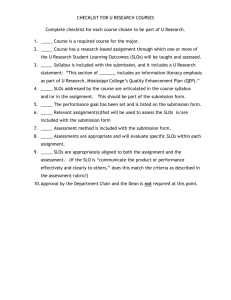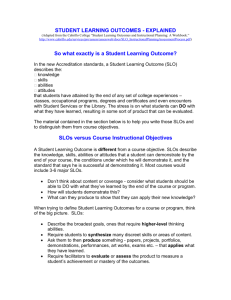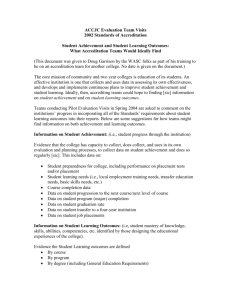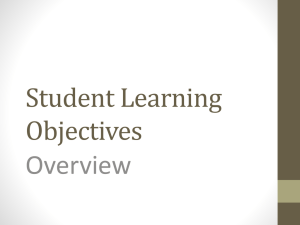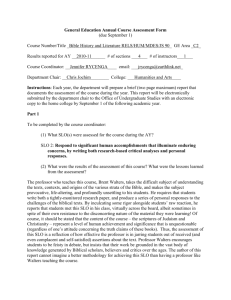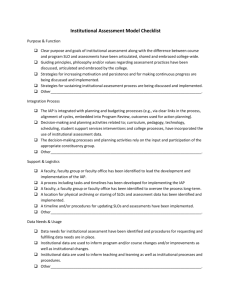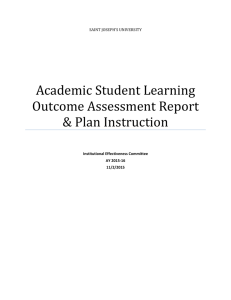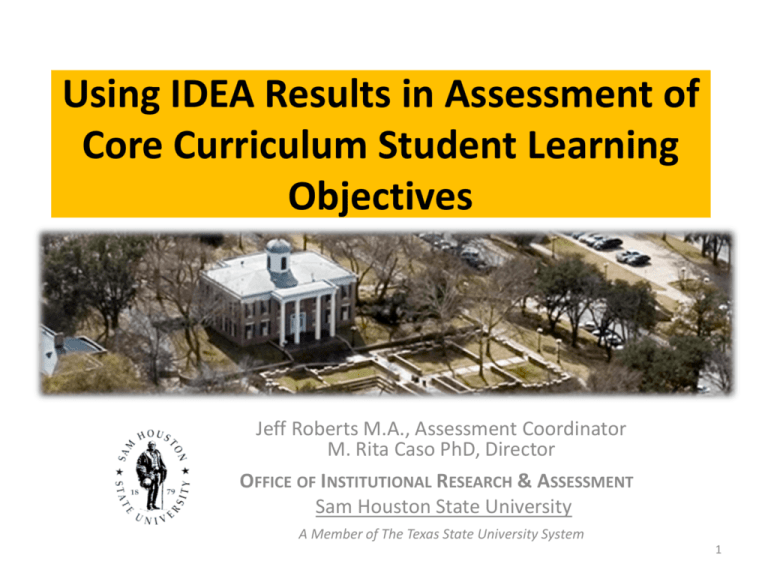
Using IDEA Results in Assessment of
Core Curriculum Student Learning
Objectives
Jeff Roberts M.A., Assessment Coordinator
M. Rita Caso PhD, Director
OFFICE OF INSTITUTIONAL RESEARCH & ASSESSMENT
Sam Houston State University
A Member of The Texas State University System
1
Core Curriculum Assessment
Considerations
TexReg 4109
•
§4.27 (effective May 27, 2003)
“Each institution’s core curriculum must be designed to satisfy the exemplary educational
objectives specified for the component areas of the ‘Core Curriculum: Assumptions and Defining
Characteristics’ adopted by the board.” (The TX Higher Education Board – THECB) (See EEO Example
in EEO-ISLO Matrix)
•
§4.30
Criteria for Evaluation of Core Curricula: (a) Each public institution of higher education shall
review and evaluate its core curriculum every five years and report the results of that
evaluation to the Board. The evaluation should include:
(1) the extent to which the core curriculum is consistent with the elements of the core
curriculum recommended by the Board;
(2) the extent to which the core curriculum is consistent with the Texas Common Course
Numbering System (TCCNS);
(3) the extent to which the core curriculum is consistent with the elements of the core
curriculum component areas, intellectual competencies, and perspectives as expressed
in Core Curriculum: Assumptions and Defining Characteristics adopted by the Board;
and
(4) the extent to which the institution's educational goals and the exemplary educational
objectives of the core curriculum recommended by the Board are being achieved
2
Core Curriculum Assessment
Considerations
Example From Sam Houston State University:
Component Area 1 - Communication 6 HOURS
Component Area 2 - Mathematics 3 HOURS
Component Area 3 - Natural Sciences 8 HOURS
Component Area 4 - Humanities & Visual & Performing Arts 9 HOURS
Select 3 hours from Visual & Performing Arts
Select 3 hours from Literature or Philosophy
Select 3 hours from Cultural Studies:
Component Area 5 - Social and Behavioral Sciences 15 HOURS
Select 9 hours from: History, Political Science, GOVT
Select 3 hours from: Political Science, GOVT
Select 3 hours from: Agriculture, Economics, Geography, Philosophy,
Psychology, Sociology, Speech Communication
Component Area 6 - Institutionally Designated –Kinesiology 1 HOUR
3
Core Curriculum Assessment
Considerations
The Commission on Colleges of the Southern
Association of Colleges and Schools (SACS)
• Compliance Criterion 3.5.1 : College-level competencies
– The institution identifies college-level general education competencies
and the extent to which graduates have attained them.
Good Practice of Program Evaluation and Universitywide Academic Assessment at ANY University
4
History of Core Curriculum Assessment at
Sam Houston State University
Assessment of the core curriculum at Sam Houston
State University (SHSU) has evolved.
• (1999) The University’s Core Curriculum Assessment Committee is
charged with developing “recommendations for an assessment process
for the University’s core curriculum.”
• (1999-2004) Student learning assessment was based upon grades
earned in core curriculum courses.
• (2004-2005) THECB’s exemplary educational objectives were mapped to
the student learning outcome objectives measured by the IDEA
Evaluation System. (EEO-ISLO Matrix example)
5
The IDEA System
• What is IDEA?
– A product of the IDEA Center of Kansas State
University, it is a class evaluation system used
nationally by hundreds of universities each semester.
– Piloted at Sam Houston State University in Spring
2005.
– Full university-wide implementation of IDEA
Evaluation System at SHSU in Fall 2005, coordinated
by Institutional Research & Assessment Office (IRA)
6
The IDEA System (cont.)
– On the IDEA Faculty Information Form (FIF)Instructors rate 12 Student
Learning (Outcome) Objectives (SLOs) in relation to each class.
•
“Important” or “Essential” or of “Minor or No Importance”
– Instructors are directed limit their “Important” or “Essential” ratings to 35 IDEA SLOs
– Students evaluate their progress on the IDEA SLOs, and on other matters
of instructional interest, using a 47 question student form. (IDEA Student
Form example)
•
Up to 20 institution-specific, questions may be added to the standard 47.
– Students rate their progress on the 12 IDEA SLOs using a 5 point Likert
Scale ranging from..
•
•
1 - “No Apparent Progress” to
5 - “Exceptional Progress; I made outstanding gains on this objective.”
– The IDEA Center scores student responses in the light of instructor
weightings of IDEA SLOs and scores are compared against national norms,
institutional norms and subject area norms in result reports.
7
How is IDEA Used to Evaluate the
Core Curriculum?
THECB EEO – IDEA SLO Matrix
• Correspondences were identified between the THECB’s
Exceptional Educational Objectives and the twelve IDEA
SLO’s, for each Core Curriculum area.
• For each Core Curriculum area a matrix was generated,
mapping the THECB EEOs to the IDEA SLOs with which
they best associated
8
Example of THECB EEO - IDEA SLO Matrix
Communications Core Area
9
How is IDEA Used to Evaluate the
Core Curriculum?
• IDEA Data for the classes within each Core
Curriculum area are analyzed to determine:
– On which of the 12 IDEA SLOs students perceive that
they have made the greatest progress
– Which of the 12 SLOs are most frequently rated by the
course instructors as Important or Essential
– If the IDEA SLOs most often rated by instructors as
Important or Essential generally match the THECB
Exceptional Educational Objectives.
10
History of Core Curriculum
Assessment at SHSU (cont.)
The evolution of core curriculum assessment at SHSU:
• (2006-2007) Institutional Research & Assessment (IRA) Office
compiled and analyzed raw student and instructor response-data
from Fall 05, Spring 06, & Fall 06 IDEA surveys, for all courses
pertaining to each of 9 Core Curriculum areas ( and sub-areas) in
order to compute…
– students’ perceived progress on the 12 IDEA Student Learning Objectives
(SLOs) and
– instructors’ ratings of their emphasis upon the same 12 SLOs.
– Agreement between student and instructor responses re. IDEA SLOs
– Alignment of student progress and instructor emphasis on IDEA SLOs with
THECB EEOs
11
Sample 2005-2007 Core Curriculum
Report: Tables 1, 2 & 3
1
2
3
12
Core Curriculum Assessment With
IDEA: 2005-2007
• Tables 1, 2, & 3
1.
A table displaying the percentages of only high level (4-5 on a
1-5 scale) responses given by students for each of the 12
Learning Outcome Objectives assessed in the IDEA instrument
rank ordered by magnitude of percentage.
2.
A table displaying the percentages of only high level (2-3 on a
1-3 scale) responses given by instructors for each of IDEA’s 12
Learning Outcome Objectives, rank ordered by magnitude of
percentage.
3.
A table displaying the number of intersections each of the 12
IDEA Learning Outcome Objectives has with each of the
Expected THECB Learning Outcome Objectives, rank ordered
by frequency of intersections.
13
Sample 2005 – 2007 Core Curriculum
Report: Tables 4 & 5
4
5
14
Core Curriculum Assessment With
IDEA: 2005-2007
• Tables 4 & 5
4.
A table of the total number of students surveyed; the
total number of student responses returned ; and the
percent frequencies of student responses at each level of
the 1-5 scale for each of the 12 Learning Outcome
Objectives assessed in the IDEA instrument.
5. A table of the total number of instructors surveyed; the
total number of instructor responses returned ; and the
percent frequencies of instructor responses at each level
of the 1-3 scale for each of the 12 Learning Outcome
Objectives assessed in the IDEA instrument.
15
History of Core Curriculum
Assessment at SHSU (cont.)
The evolution of core curriculum assessment at SHSU:
(2007-2008)
• Using only response data from Academic Year (AY) 2007-2008, the
SHSU IRA Office repeated the raw IDEA data compilation and
analysis process from previous year, computing the same IDEA
SLO student progress and instructor emphasis measures for
comparison
• The organization of courses in the sub groups within some very
broad Core Areas was modified to achieve greater response
coherence from courses that were more alike
• The number of data summary tables reported was reduced to 3
16
Sample AY
2007-2008
Core
Curriculum
Report
17
History of Core Curriculum
Assessment at SHSU (cont.)
The evolution of core curriculum assessment at SHSU:
(2007-2008)
• Direct Assessment of student learning through embedded
assessment, IS ADDED TO previously mentioned IDEA SLO
measures.
– The Core Curriculum Assessment Committee ordered the
Collection of directly measured evidence of student learning
and the collaborative creation of rubric-based instruments by
the academic departments within core-areas
–
The SLOs that were directly assessed in courses were aligned with
the THECB exemplary educational objectives for pertinent coreareas.
18
Direct vs. Indirect Assessment
Definitions
• Direct Assessment:
– Observation and first-hand evaluation of student outcome
behaviors or their products
– Specific student skills or knowledge are judged against
standards of excellence external to the student
– Outcomes of student learning are tested; or products of
learning outcomes are collected (papers, portfolios,
performances) and evaluated, using scales or rubrics
• Indirect Assessment:
– Collection of student-reported perceptions, or opinions of
their own learning
– IDEA indirectly assesses student learning because it asks
them to evaluate and report their own progress.
19
Direct vs. Indirect Assessment
Qualifications
• Direct assessment of student learning outcomes is
always superior to Indirect assessment;
• Indirect assessment can add depth and nuance to
direct measurement by providing insight into the
learner.
• Under certain circumstances, direct assessment is
not possible. Then, systematic and consistent
indirect measures (preferably more than one kind)
can serve as proxies
20
Core Curriculum Assessment With
IDEA Fall 2007-Spring 2008
• Departments in most core-areas responded, however,
those in the Communication (English) and Math core areas
were most successful at collaboratively formulating
assessment instruments that met all of the following
criteria:
– Could be used by all instructors across several courses
– Could be embedded within regularly scheduled class
testing for convenient administration.
– Could provide evidence of learning directly related to the
THECB “Exemplary Objectives” for their particular corearea.
21
Methodology of Direct Core Curriculum
Assessment From the Department of English
• Students taking Freshman English were asked to write a short
essay on the following prompt from The Longwood Guide to
Writing, Custom Edition, (Lunsford and Bridges, Boston:
Pearson Longman, 2005):
“Identify a problem, something that bothers you. Explore it, and offer
a possible solution. The first part of your job is to identify a specific
problem, define it clearly, and explore its implications. The second
part is to consider potential solutions, evaluate those solutions, and
then make an argument for the one you think is best.”
• A random collection of the short essays (78 of 530, or 15%)
were graded on a 4 point scale using a rubric that had been
aligned with relevant THECB exemplary educational
objectives.
22
Rubric for English Core Curriculum
Assessment
23
Methodology of Direct Core Curriculum Assessment
From the Department of English, (cont.)
• Each essay was evaluated by an independent faculty
member with each giving a score. Both scores were
then combined to provide a final score for the essay.
• Essays with a score of 5 or higher were deemed to
demonstrate satisfactory attainment of the desired
core competencies.
24
History of Core Curriculum
Assessment at SHSU (cont.)
Evolution continues:
(2008-2009)
• More direct assessments of student learning are
coordinated across courses within core curriculum areas.
• IDEA Center summary reports are ordered from the IDEA
Center with aggregated results of all classes in each core
curriculum area. These reports provide data for comparing
student SLO progress vs. instructor SLO weighting, and for
examining correspondences between IDEA SLO results and
the THECB EE0.
25
AY 2008-2009 Improvements on Core
Curriculum Assessment with IDEA
• Following the time consuming process of creating the AY 2007-2008
Core Curriculum Report, the IRA Office investigated the reduction of
time and work in the production for future IDEA assessment reports
by strategically coding IDEA data from Core Curriculum courses such
that the IDEA Center could produce aggregated summary reports
for each core curriculum area
• The IRA Office IDEA Coordinator manipulated the “Local Code”
feature in IDEA to flag the classes comprising the different Core
Curriculum Areas.
– Using the Local Codes, aggregated reports could be ordered from the
IDEA Center for each Core Area that could provide the same or
comparable basic information as had been previously generated by
the IRA Office at much greater great effort
26
AY 2008-2009 Improvements:
IDEA Center Reports Ordered by Core Curriculum Areas
•
•
•
•
•
•
•
•
•
•
Core Area I – Communication
Core Area II – Mathematics
Core Area III – Natural Sciences
Core Area IV A – English/Philosophy
Core Area IV B – Visual and Performing Arts
Core Area IV C – Cultural Studies
Core Area V A – History/Political Science
Core Area V B – Social/Behavioral Sciences
Core Area VI A – Kinesiology
Core Area VI B – Computer Science/Library Science
27
Excerpts from the Fall 2008 IDEA
Group Summary Report for Core
Curriculum
Area I – Communications
28
Percent of
Instructors
Rating Each
IDEA SLO
Objectives
“Important”
or
“Essential”
29
Student
Rating of
Progress on
IDEA SLOs
30
Student
Rating of
Progress on
the 12 IDEA
SLOs,
(cont.)
31
Additional Information Provided by
the IDEA Group Summary Report
• In addition, the Group Summary Report provides
other valuable information.
– Comparison of scores to similar courses within the
IDEA Database, and to past SHSU results, for the
following categories:
• Progress on Relevant Objectives
• Excellence of Teacher
• Excellence of Course
– Additional student perceptions regarding their
involvement and interest in the course, course
difficulty, as well as the effort they put forward
32
History of Core Curriculum
Assessment at SHSU (cont.)
The Future:
(2009-2010)
• Addition of measures from the CLA, MAAP or CAAP for the
assessment of core curriculum learning, as part of the
Association of American State Colleges and Universities’
(AASCU) Voluntary System of Accountability (VSA).
• Continued improvements in embedded direct assessment
and increased reliance upon IDEA Center reports for
shortcuts in computing IDEA SLO concordances among
students, instructors and THECB EEOs.
33
Conclusions
34
Uses for IDEA in Core Curriculum
Evaluation
• Used to help address #1 and #4 of the THECB Criteria for
Evaluation of Core Curricula:
Criteria for Evaluation of Core Curricula: (a) Each public institution of
higher education shall review and evaluate its core curriculum every five
years and report the results of that evaluation to the Board. The
evaluation should include:
(1) the extent to which the core curriculum is consistent with the elements of the
core curriculum recommended by the Board;
(2) the extent to which the core curriculum is consistent with the Texas Common
Course Numbering System (TCCNS);
(3) the extent to which the core curriculum is consistent with the elements of the core
curriculum component areas, intellectual competencies, and perspectives as
expressed in Core Curriculum: Assumptions and Defining Characteristics adopted
by the Board; and
(4) the extent to which the institution's educational goals and the exemplary
educational objectives of the core curriculum recommended by the Board are
being achieved
35
Uses for IDEA in Core Curriculum
Evaluation
IDEA results were used to demonstrate:
1. That there was a correspondence between the SLO’s being
selected by the faculty and those identified by the
THECB/IDEA matrix.
2. That the students perceptions of their progress on those
same objectives would be high.
3. That there would be a high correspondence between the
SLO’s rated most important by faculty and those in which
students perceived greatest progress.
36
How Else is IDEA Used at SHSU?
• Student feedback to Instructors and Departments regarding their
perceptions of class instruction and self-reported areas of learning.
• Evaluation of classroom instructors at SHSU for tenure and
promotion.
• Monitoring, tracking and comparing self-reported student learning
and interest in courses targeted within program evaluation plans
– (i.e., ..courses that are part of the SACS QEP Initiative vs. comparison
courses; Baseline and Post measurement for assessing value-added).
• Evaluation of self-reported student progress on key learning
objectives.
37
Contact Information
• M. Rita Caso, PhD, Director, Institutional Research & Assessment
– DR_RITA@shsu.edu
– (936) 294-3618
• Jeff Roberts, MA, Assessment Coordinator , Institutional Research &
Assessment
– JLR022@shsu.edu
– (936) 294-4321
38

